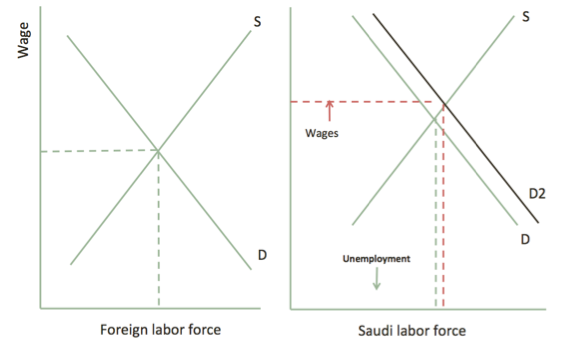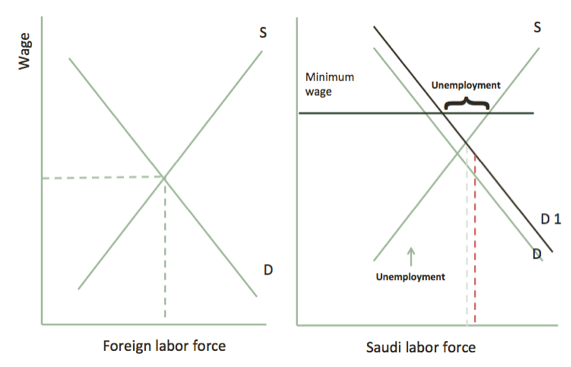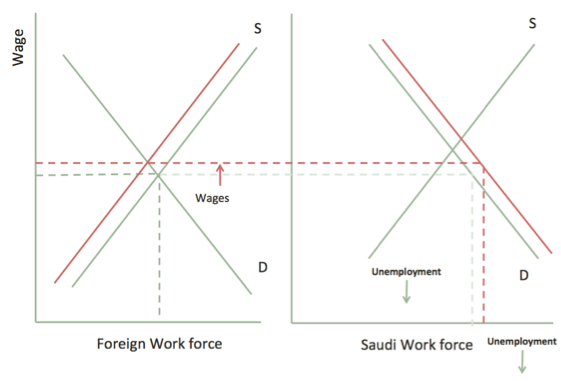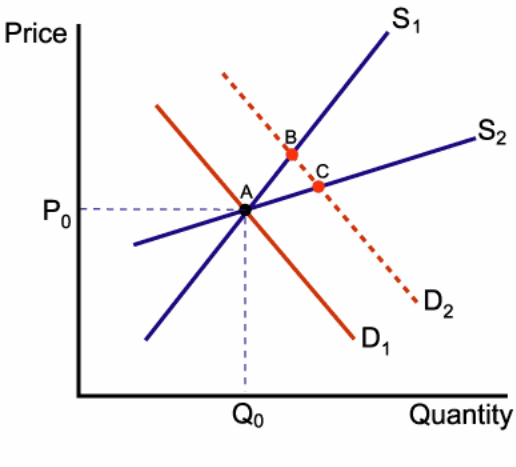Introduction
The national wage structure influences socioeconomic indicators such as poverty and unemployment levels. It specifies the statutory minimum wages for the low-tier workforce in commerce, industry, and other sectors. Nations that have ratified the ILO conventions have mechanisms and procedures for setting the minimum wage in line with their socioeconomic development policies. The minimum wage is the lowest statutory limit of remuneration for wage earners in different sectors or regions.
In Saudi, in a bid to foster Saudization, the labour ministry sanctioned a monthly minimum wage of $800 in 2012, causing a shift in labour demand and supply (Saudi Ministry of Labour 2). This research paper examines the notion of fair wage and the impact of minimum wage policies on the Saudi vs. Malaysia’s labour markets. It also explores the correlation between higher wages and workforce productivity.
Fair Wage
The minimum wage delimits the lowest remuneration sufficient to meet family needs, taking into account the economic indicators, type of occupation, and collective bargaining considerations (“The World Factbook: Saudi Arabia” par. 8).
Nations reserve the discretion, under the ILO convention number 131, to fix statutory minimum wage rates through a consultative process involving social actors from different industries or sectors (“The World Factbook: Saudi Arabia” par. 14). Therefore, minimum wages may differ depending on the type of sector or enterprise. Fair wage encompasses better working conditions, employment benefits, and social security to reduce income inequalities and improve living standards.
The key attributes of fair wage include regularity of the payment, lump-sum pay, and non-discriminatory practices. A fair wage is a product of an impartial wage structure that considers not only variables such as job skills, competencies, and professional experience, but also the working conditions of the workforce.
The concept of fairness in the minimum wage also discourages the practice of subjecting workers to long working hours. Therefore, a fair wage is the minimum living wage that “just share of the fruits of progress” and improved performance (International Labour Office [ILO] 103). In this respect, the fair wage expands the concepts of the living wage and minimum wage to include the conditions of work.
The minimum wages in the production industry vary widely even among manufacturers involved in the same line of business. In 2014, the global minimum wage for the clothing and textile sectors averaged 35% and 25% lower than the overall rate in the production industry (“The World Factbook: Saudi Arabia” par. 24).
Salary levels varied between €752 and €1,442 for skilled and unskilled workers, respectively. In most countries, textile sector wages are substantially higher than clothing sector wages (“The World Factbook: Saudi Arabia” par. 26). The differences stem from the fact that public agencies set a different rate for each sector.
A key attribute of a fair wage is non-discrimination of workers. In countries like Cambodia, male workers earned 13.3% more than their female counterparts between 2004 and 2008 did, contravening the concept of fair wage (“The World Factbook: Saudi Arabia” par. 17). Male workers, in both clothing and textile factories, occupy managerial roles, and thus, earn better compensation than female workers receive.
The ILO requires countries to create laws that protect workers against excessive work hours, entitle them to annual leave, and provide overtime compensation (92). Thus, minimum wages in the textile and clothing factories negate the fair wage concept as employees work long hours without overtime compensation and do not receive the recommended leave days.
A Comparison of Minimum Wage Policies: Saudi Arabia vs. Malaysia
Saudi Arabia
In 2011, the Saudi Ministry of Labour launched the Nataqat policy to boost the population of locals in the workforce and reduce unemployment. The Nataqat, which is Arabic for ‘zones’, groups firms in Saudi, including multinational companies, into four categories, “red, yellow, green, and platinum” based on the proportion of Saudi nationals employed (Saudi Ministry of Labour 5).
Depending on the category, a firm can enjoy certain privileges or receive sanctions (red zone) for employing a disproportionate number of expats. The policy has increased the demand for Saudi professionals and increased the minimum wage rate, causing the demand curve to move to the right. The effect of this policy has had on the demand curve can be illustrated as shown in Graph 1 below.
Graph 1: The effect of the Nataqat policy on minimum wage

Before 2012, Saudi Arabia had no policy to guide minimum wage rates across various sectors (Saudi Ministry of Labour 2). In 2012, the Saudi government set a statutory monthly rate of $800 for both public servants and private sector employees. Subsequently, the Saudi Ministry of Labour created a legislation demanding that all Saudi nationals employed in private firms be remunerated over the minimum wage for a company to qualify for Nitaqat privileges (6).
In this respect, most Saudi workers earn an income exceeding $800 per month. The higher minimum wage encouraged the Saudis to work. The competitive wages coupled with the favourable Nataqat policy had a dual effect of driving the demand for Saudi labour force to the right and reducing unemployment levels as shown in Graph 2 below.
Graph 2: The effect of minimum wage policy on labour demand

The Saudi authorities implemented stricter work permit laws for foreign workers in 2012. Expatriates pay up to $650 per annum to receive a one-year renewable work permit (Saudi Ministry of Labour 4). The same law also prohibits them from switching employers in the middle of their contract. These laws led to an increase in the supply of local labour force while that of expatriates declined by up to 20% in one year (“The World Factbook: Saudi Arabia” par. 6). The implementation of these initiatives led to an increase in the minimum wages as well as the demand for local workers.
Graph 3: The effect of employment statutes on labour supply

The minimum wage rate implemented in Saudi has led to an increase in the supply of local workers. However, the Nitaqat and stricter laws that limit the number of expats in the country have increased the demand for Saudi workers.
Malaysia
The Malaysian government adopted different minimum wage laws in 2013 for various regions. Accordingly, the monthly minimum wage stands at “RM900 or $216 for Peninsular Malaysia and RM800 or $192 for Sabah, Sarawak, and Labuan” (Yuen 19). The policy aims at promoting the standards of living of 27% of the workforce and their households while incentivising investment inflows.
The multiple rates have increased the minimum wage of agricultural sector workers across Malaysia. The policy has also enhanced labour efficiency and participation, eliminating market distortions (Yuen 21). Unlike Saudi, Malaysia’s unemployment levels have remained low since implementing the policy while the demand for labour continues to rise.
Yuen attributes this trend to Malaysia’s strong economic structures and a stable labour market (23). Therefore, Malaysia’s minimum wage policy has caused the demand curve to shift to the right while the unemployment levels have remained low, indicating that the supply of the workforce matches the demand.
Unlike Saudi Arabia, Malaysia has a low proportion of foreign workers. Therefore, Malaysia does not have the unemployment problem (surplus labour force) experienced by Saudi Arabia. The influx of foreign workers into Saudi increases labour supply, affecting minimum wage rates.
Nonlocal workers from low-income countries are preferred to the Saudis by multinational enterprises because they earn lower wages than their Saudi counterparts do. However, policy initiatives such as the Nitaqat have the potential of limiting the number of expatriates entering Saudi to stabilise the labour market.
Strategies for Solving the Low-Wage Problem
Countries employ a variety of mechanisms ranging from persuasion to sanctions to address minimum wage challenges. Persuasion centres on the concepts of ‘fair play’ in minimum wage matters. Public authorities use persuasion as a strategy to build a “culture of compliance” among employers (ILO 77).
Persuasive actions can occur at interpersonal or societal level. For example, interpersonal discussions between the US authorities and coal-mining firms in the 1980s enhanced compliance with fair wage and safety provisions (ILO 92).
Persuasive processes can also occur at the societal level whereby employers who fail to meet the minimum wage requirements are depicted as unfair and exploitative. In the US, the government promoted the living wage in the 1990s as the “means of achieving individual independence” (ILO 81). In response, county authorities enacted laws requiring local firms to raise their wage level above the national minimum wage.
Countries also establish minimum wage regulations to enhance compliance. The minimum wage is arrived at through a consultative process involving the government, firms, workers’ unions, and social actors, making it legally binding. The collective bargaining process yields a mutually agreed rate that is institutionalised by the public authorities. The process enhances compliance because it entails binding agreements as opposed to top-down federal regulations.
For example, the Uruguayan government, in 2006, established wage councils charged with the responsibility of minimum wage fixing and review (ILO 55). The intention was to tame plummeting minimum wage levels and improve the standards of living. The approach saw the monthly minimum wage nearly double (176%) between 2000 and 2008 (ILO 118).
The tripartite wage fixing process in Uruguay helped bridge the income gap between male and female workers and regions. It also ensured a common understanding of the minimum wage regulations by employers and employees. In this regard, the country implemented a national minimum wage system, as opposed to a sector-specific wage to solve its low wage problems.
Besides regulation, governments use capacity-building measures to foster compliance. Employers and workers receive training to build their capacity to comply with the minimum wage law. This strategy empowers workers and enhances their understanding of employee rights.
Public authorities and trade unions spearhead capacity-building initiatives in the US and the UK to increase minimum wage awareness in key sectors such as hospitality (ILO 121). The initiatives primarily centre on minimum wage implementation and working conditions. The aim is to prevent underpayment stemming from the lack of information about the minimum wage and improve the enforcement of labour standards in at-risk industries.
Governments also use labour inspections and monitoring to enhance compliance with the statutory minimum wage. Labour inspection entails monitoring the compliance of a firm with wage rates to identify and punish non-compliant employers (ILO 119). Workers and unions can also monitor the employers’ compliance with labour standards.
Arbitration councils also exist to resolve disputes out of court. In the US and Switzerland, tripartite arbitration councils comprising of representatives of the government, workers, and firms examine collective agreements and make determinations related to minimum wage violations.
Minimum wage violations attract legal sanctions, including hefty fines, in countries that have ratified the ILO conventions. The fines are meant to deter non-compliance with minimum wage provisions. Usually, non-compliant employers are forced to give a payback compensation equivalent to the minimum salary multiplied by the number of times the offence has been repeated (ILO 116).
In the US, criminal prosecution is possible for offenders breaching the minimum wage provisions. Besides sanctions, boycott campaigns and blacklisting of firms constitute other effective tools for enforcing the minimum wage law in the US.
Higher Wages and Productivity
Labour market trends indicate that the wages paid out to workers are not commensurate with the national productivity (gross output) levels. Labour productivity is the “output value produced by a worker, a firm, a sector, or a country per a unit of labour input” (Biesebroeck 61). Outputs can be the physical products that come from a production process, sales, or revenue. Labour input measures the amount of work or hours worked depending on the sector and skills required and adjusting for energy requirements and raw materials.
In neo-Keynesian models, factors that affect worker productivity also influence wages. In this regard, a decline in productivity will affect employment and wage levels (Biesebroeck 65). Even in inelastic labour demand and supply curves, productivity is equivalent to market wage (price) levels as illustrated in Graph 4 below.
Therefore, in the long-term, growth in productivity will lead to a rise in the average wage levels. Changes in labour demand (D1 to D2) increase wages, which, in turn, translates into productivity growth as employees are motivated to work more. Conversely, a decline in demand reduces wages, affecting labour productivity.
Graph 4: The correlation between labour supply/demand and wages (P)

Factors such as worker heterogeneity and location of work affect the wage-productivity relationship. Workers occupy different positions based on their skills, and therefore, productivity is different for each class of employees (Biesebroeck 72). The location of work also determines the wages a firm pays its employees in line with the country’s minimum wage laws. In Saudi, the wages are higher for foreign and local workers.
The adoption of strict employment laws has reduced labour supply, raising the demand for local unskilled workers. In this regard, despite the competitive wages, productivity may decline in Saudi because of the semi-skilled local labour force. In the long term, wages may decline in response to lower productivity.
Conclusion
Countries implement minimum wage policies to improve the standards of living of the labour force and stabilise the labour market. Saudi’s minimum wage policies have evidently reduced unemployment in the country. Wages have also increased, as demand and supply remain steady. However, the labour laws may affect productivity, leading to a drop in average wages.
Works Cited
Biesebroeck, Johannes. How Tight is the Link between Wages and Productivity? A Survey of the Literature. Geneva: International Labour Organization, 2015. Print.
International Labour Office [ILO]. Minimum Wage Systems. Geneva: International Labour Conference, 2014. Print.
Saudi Ministry of Labour. Annual Statistics Report. Riyadh: Saudi Ministry of Labour, 2012. Print.
The World Factbook: Saudi Arabia 2013. Web.
Yuen, Joyce. “Minimum Wage Policy in Malaysia: Its Impact and the Readiness of Firms.” World Applied Sciences Journal 28 (2013): 19-26. Print.